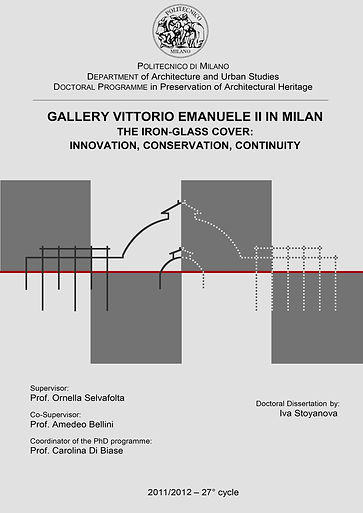

/Architecture studio ACCA 2000

/PhD
Stoyanova, I., 'Gallery Vittorio Emanuele II in Milan. The Iron-Glass Cover: Innovation, Conservation, Continuity', PhD thesis, Polytechnic University of Milan, 2015.
PhD programme: Preservation of Architectural Heritage, 27° cycle
Research period abroad: æ-lab, Vrije Universiteit Brussel
Doctor Europaeus

ABSTRACT:
Gallery Vittorio Emanuele II is one of the most remarkable examples of 19th-century European arcades that are still standing today. The history of its ideation as a large-scale urban operation in the heart of 19th-century Milan, of its architectural design and of its construction, reflected victorious national events and complex cultural values. The Gallery is an emblematic piece of heritage and an outstanding example of monumental urban architecture.
The iron-and-glass roof is a key feature of this architecture. Its large dimensions and monumental effect were unrivaled by already-constructed arcades. The dome was recognized internationally as a powerful example of iron-and-glass architecture. Due to this significance, the iron-and-glass roof deserves a more profound investigation in terms of original construction technology, creativity and monumental spatial effect.
Unpublished sources allow reconstructing the original building technology of the roof in detail. Comparison to preceding arcades, such as Brussels Galleries Saint-Hubert, highlights the deep relation between the building technology of the roof and the monumental effect inside the Gallery.
A closer look into the conservation history of the roof reveals a number of cases of special and routine maintenance. They were handled by means of various techniques and materials. Archival research shows how traces of an appreciation for the historical value of the roof had started to appear already before the Second World War. Investigation of post-war periodicals report on roof components that were conserved and substituted in the post-war reconstruction.
The goal of this doctoral dissertation is not only to cast more light on the original construction technology and on the conservation history, but also to define the complex identity of today's roof as a key feature of the Gallery's heritage. The roof deserves a more sophisticated approach in future preservation campaigns.